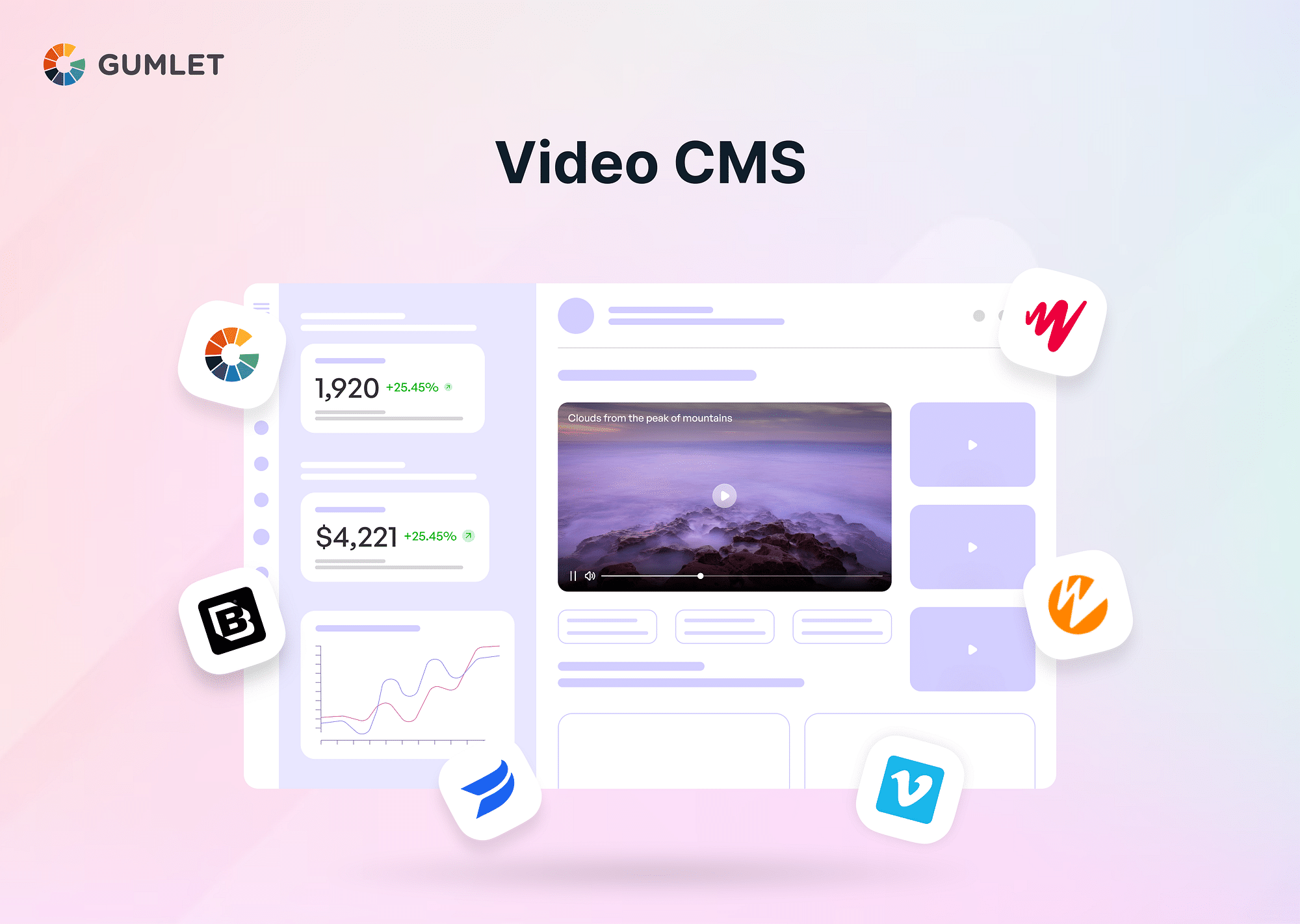Introduction
Video content creation and distribution are crucial for online communication and marketing. Video Asset Management (VAM) is essential for efficient digital media pipelines. Traditional platforms lack functionality, leading to the introduction of one-stop platforms like Gumlet. Gumlet offers secure streaming, deep analytics, and latency metrics, making it a modern-day VAM platform with robust features.
What is Video Asset Management (VAM)?
Video Asset Management (VAM) refers to the systematic management of video files or assets within an organization. It involves looking after every stage of a video’s lifecycle, from storage and organization to retrieval and distribution. Robust VAM systems are often used by businesses and organizations that deal with large volumes of video content on a daily basis.
Importance of Video Asset Management System for Businesses
In the modern context, video content is the name of the game. According to a survey, 83% of respondents preferred watching videos (rather than text or audio) to access the required information.
Considering this demand, companies have shifted their content creation dynamics, producing large volumes of video media files daily. Without a proper system to manage them, the efficiency of data storage, distribution, and organization will suffer immensely. To counter this problem, companies must equip themselves with a robust Video Asset Management system.
Problem with Traditional Video Management
The concept of video management predates the era of digital media on the internet. At that time, traditional Video Asset Management solutions were used to look after a company’s media portfolio. But as demand and supply flourished, the need for a newer and stronger solution grew too. This is because traditional VAM software had some prominent limitations:
- Slow Loading Times: Traditional video management systems suffered from slow loading speeds, significantly affecting user experience and overall viewer engagement.
- Limited Storage Capacity: Given the demand of that time, older VAM systems had a rigid limitation on the number of videos that could be stored. However, as video-related content grew exponentially, these systems were bound to become obsolete with time.
- Weak Downloading Capabilities: Older VAM solutions were not designed to be accessed by multiple users at once. Different departments trying to use the software simultaneously can significantly decrease the downloading speed.
- Incapable of Collaboration: Modern video managers are equipped with collaborative capabilities. Different users can access videos end-to-end for editing, modifying, or anything else. Older systems simply did not provide this privilege.
- Complex Organization Structures: While older VAM solutions could organize videos, their capabilities were severely limited. For example, they were not as efficient at storing video metadata as modern-day platforms.
- Lack of Security: Modern platforms are equipped with robust security measures to protect a company's digital assets. Traditional VAM systems do not offer this feature.
How Does VAM Software/System Help?
Traditional Video Asset Management practices had a lot of room for improvement. But with modern VAM systems at play, companies can now leverage the full power of video content to optimize growth and marketing strategies.
Here’s how:
- Organized Asset Storage: Modern VAM solutions store video data in a centralized location. This allows efficient organization of valuable company assets, saving time and resources effectively.
- Strong Collaboration Capabilities: Modern video managers can provide collaborative powers to different users. Multiple people can work on the same video in real-time. Edits and feedback can be shared on the go, with all the information being communicated over the cloud.
- Regular Updates: One of the strongest features of modern VAM solutions is that they enjoy regular updates. Automatic upgradation is enabled and reaches all stakeholders to ensure everyone works on the same tangent.
- Efficient Editing and Resizing Capabilities: Videos can be edited and resized conveniently to make them industry-ready and easy to upload on the internet, social media, and other platforms.
- Copyright and DRM Protection: Video assets of a company are protected by patents and copyrights using robust VAM platforms. In addition, Digital Rights Management (DRM) protection is also enabled to protect your asset from unauthorized access or piracy.
Best Video Asset Management Software for Your Business
Looking for the perfect VAM solution that is tailor-made as per your requirements? We might be able to lend you a hand.
Top Features to Look Out for in a VAM System
A top, impeccable VAM system should offer these functionalities:
- Storage and Organization: The platform should be able to offer scalable, cloud-based storage options to accommodate growing volumes of video content. Organization features should also be present, including customizable metadata tagging, categorization, and folder structuring.
- Search and Discovery: It should provide intuitive search functionalities for rapid and precise content retrieval. The features to look out for are advanced search algorithms, metadata filters, keyword tagging, etc. Some modern platforms even provide AI-driven content recognition technologies.
- Collaboration: Users should be able to engage in real-time editing, commenting, and annotating to foster teamwork and collaborate with each other in real time. Version control and regular updates should also be provided to ensure all users are working in tandem.
- Security: The platform should use encryption protocols to safeguard files while in transit and at rest. Access control and user permissions should ensure that only authorized personnel can view, edit, or download specific content. DRM and copyright protection should also be offered to safeguard video assets from privacy or unauthorized access.
- Analytics: Nowadays, video management goes beyond the scope of just storing, organizing, and retrieving video content. Advanced analytics tools are also packaged under this category. Engagement metrics like views, engagement rates, and geographic locations should be monitored and tracked using VAM systems to gain valuable insights into viewer behavior.
- Video Processing Quality: Modern VAM solutions are equipped to support high processing quality in multiple formats and resolutions. Features like automatic transcoding also ensure that videos are optimized to be viewed and accessed by different devices and internet speeds.
- Global CDN (Content Delivery Network): Global CDN ensures that videos are efficiently delivered to viewers worldwide. CDN helps minimize buffering, reduce latency, and accelerate load times.
4 Best Digital Asset Management Software for Your Videos
We have already given you a list of all the top features that most modern-day VAM platforms should be able to provide. But to actually find the right software could be a huge task. To help you out, we have compiled a list of four of the most renowned VAM solutions on the market today.
Brandfolder
Best Enterprise Solution for User-Friendliness
Brandfolder is one of the most popular DAM (Digital Asset Management) software that offers intuitive and user-friendly solutions for storing and managing video content. It allows basic operations like storing, managing, sharing, manipulating, and analyzing video assets.
In addition, it also offers functionalities like SmartCDN, collaborative workspaces, and more.
Best Features:
- AI-led tagging and analytics.
- Custom templates.
- Content automation.
- Authorization for external partners to upload files within the system.
Pricing:
Free demo available. Individual pricing is based on request.
Canto
Best for Small and Mid-Sized Companies
Canto is a great organizer of video assets. It stores information conveniently and in a collaborative way. It also provides strong search mechanics, collaborative workspaces, and a robust customer support system for users.
Best Features:
- AI-driven facial recognition search.
- Customizable user permissions.
- Visual previews of video content.
- Customizable interfaces.
- Downloadable presets.
Pricing:
15-day free demo available. Individual pricing is based on request.
MediaValet
Best Scalable Solution for Large Companies and Enterprises
MediaValet is one of the largest service providers in the industry, operating in over 140 countries. It features advanced search and tagging features along with strong artificial intelligence support systems. It also provides transcript generation and subtitle services in more than 60 languages.
Features:
- Multi-categorization of assets.
- Top-grade security features.
- Artificial Intelligence-tagging.
- Transcript and subtitle generation.
Pricing:
Free demo available. Individual pricing is based on request.
Bynder
Best for Mid-Sized and Large Companies
Bynder is one of the largest DAM companies that provides a user-friendly interface to clients. It focuses on strong collaboration and consistency. It also allows integration with Digital Asset Transformation (DAT) to give you access to advanced features like resizing, focus cropping, removing asset backgrounds, and more.
Features:
- Centralized storage point for all assets across the entire brand.
- Simplified file searching algorithms.
- Built-in security protocols and two-factor authentication.
- User rights and access control.
- Digital Asset Transformation integration.
Conclusion
The increasing demand for video content within organizations necessitates the implementation of robust Video Asset Management practices. Today's VAM platforms have evolved far beyond mere storage and organization, incorporating cutting-edge capabilities such as AI-driven tagging, detailed analytics, and enhanced security protocols. These advancements ensure that businesses can effectively manage, analyze, and protect their video assets.
Frequently Asked Questions (FAQs)
1. Who can benefit from using Video Asset Management software?
Content creators, businesses, media organizations, customer support executives, business development and sales reps, marketers, and even customer onboarding experts can benefit from using VAM solutions.
2. What are the other types of asset management?
Other types of asset management include Digital Asset Management (DAM), Document Asset Management, Enterprise Asset Management (EAM), and so on. Each of them specializes in managing specific types of resources.
3. How much does a VAM system cost?
There is no standard or universal price for a VAM system. The overall cost will depend on the variety of features and scale. As such, pricing models of different VAM platforms are customized according to the client’s demands.
4. What are the benefits of using a cloud-based VAM system?
Cloud-based VAM systems offer scalability, remote access, automatic updates, and improved cost-effectiveness.


